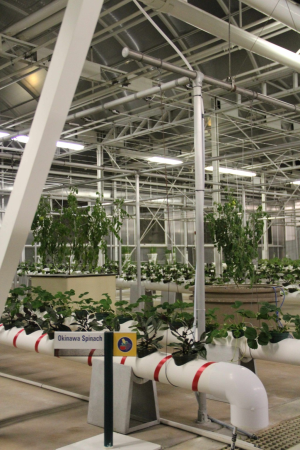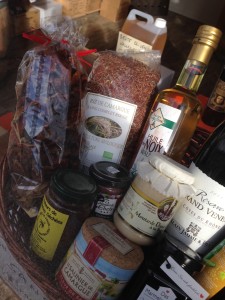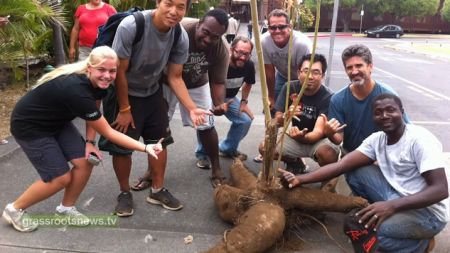- CIP’s genebank in the limelight.
- Egypt’s genebank in the limelight.
- Australia’s genebank in the limelight. Limelight fast running out…
- Ah, but genebanks not the only ones with cool videos: farmers in the limelight.
- Yeah, it’s not just about the genebanks. Markets can help, I suppose. Especially if you have a famous name.
- As with coffee, so with sorghum. Biofortified or not. All we need now is an agribusiness incubator, and here it is, courtesy of ICRISAT. But what will Japanese farmers think?
- Same again for assorted African oils?
- The diversity of cows has been driven by markets too.
- Coffee 101 at UCDavis. Maybe they’ll invite Mr Marley to teach.
- You want fructose in that coffee? No, probably not.
- Maybe you prefer chocolate. From Vanuatu, natch. Looks like high quality stuff too, but even crap chocolate has its uses, like teaching taxonomy for instance.
- No, you’re more a Japanese bourbon person, aren’t you? Wait, do you need barley for that? I’m sure those young Japanese farmers will be all over this.
Eat up all your Okinawa spinach
Speaking of Amanda, she also recently went on the Living with the Land boat ride at the Epcot theme park at Walt Disney World in Florida.
A relaxing 13-minute boat ride takes you on an informative journey through a tropical rain forest, an African desert complete with sandstorm, and the windswept plains of a small, turn-of-the-century family farm. Guests experience the struggles of the past and plans for farming in the future including Hydroponics, Aeroponics and Aquaculture. It’s not just about fruits and veggies, fish farms are on display. Since The Land is a Disney restaurant supplier, You could very well be seeing your entree. Wonder where those Mickey shaped cucumbers in your salad came from? This is where they’re grown. The educational content on this ride is geared more towards adults, but younger guests will love the boat ride and spotting the different fruits and vegetables.

Very educational, I’m sure. Anyway, this photo of hers featuring Okinawa Spinach caught my eye, even more than the Mickey shaped cucumbers, because I’d never heard of the stuff. Turns out to be Gynura bicolor, and to have really few accessions in the world’s genebanks. I wonder why Disney World picked on it in preference to any number of better known Asian vegetables. And whether they sell seeds in the gift shop. But it’s certainly one way to stimulate interest in a neglected species.
A cassava for the ages in Hawaii
Probably the biggest cassava you’ve ever seen, weighing in at about 80 kg. No word on what variety it is, alas, nor how long it was in the ground for.
Nibbles: New potatoes, Wild species, Native maize, Conservation course, Indigenous fishery, Yield trends
- Wild relative rescues potatoes. Which wild relative? Well for that you’ll have to read the paper. The FAQ on that. Or if you want an alternative. More the better, I guess. And just to remember what makes it all possible: diversity in fields and genebanks.
- Wild species not just useful to food security as sources of genes, of course. And more.
- Indigenous peoples save corn.
- Maybe some of them would be interested in this MSc at Bangor.
- Indigenous peoples can catch — and save? — fish after all.
- So is there stagnation in yield increases or what? Lobell reviews book that says maybe not.
A plateful of Camargue Red Rice
 How far back into the mists of time, do you suppose, have the French versions of the fabled gnarled rustics of Sicily been nurturing the equally fabled red rice of the Camargue? The question occurred to me as I walked past a shop window in Bonn recently, and saw this delectable display of various products of that region, including said rice. Well, it turns out that although rice has been grown in the Camargue for centuries, this particular, trendily healthy variety is of somewhat more recent vintage.
How far back into the mists of time, do you suppose, have the French versions of the fabled gnarled rustics of Sicily been nurturing the equally fabled red rice of the Camargue? The question occurred to me as I walked past a shop window in Bonn recently, and saw this delectable display of various products of that region, including said rice. Well, it turns out that although rice has been grown in the Camargue for centuries, this particular, trendily healthy variety is of somewhat more recent vintage.
A chance cross between the wild rice and a short grain rice was discovered in 1983 by a René Griotto (died 1989.) He found it growing at the foot of the Montmajor Abbey. Development of the cross was pursued in conjunction with the French “Institut national de la recherche agronomique” (INRA.) They’d grow plants, select seed from certain plants, then grow those, till finally they settled on the plant breed known today as Camargue Red Rice.
Wild rice? What wild rice grows in France? I asked my go-to guy for everything Oryza:
Must be weedy rice introduced with a crop. France is way outside the known limits of distribution of wild rice. 100 years ago a red rice introgression would have been rigorously weeded out. In the 1980s Europeans were becoming aware of the health benefits of non-white food. I wonder if they actually thought red rice = anti-oxidants = anti-cancer, which is today’s mantra.
Here’s some more from an FAO publication on weed management:
The seeds of most weedy biotypes of O. sativa and O. glaberrima have a pigmented pericarp resulting from the presence of a variable content of different antocyanins, cathekins and cathekolic tannins (Baldi, 1971).
The red pigmentation is a dominant character and is controlled by more than one gene (Leitao et al. 1972; Wirjahardja et al. 1983)
The red layer of the weed grains harvested with the crop should be removed with an extra milling but this operation results in broken grains and grade reduction (Smith, 1981; Diarra et al. 1985a, 1985b).
Weedy biotypes of O. sativa have been differentiated into indica or japonica types, on the basis of the morphological and physiological traits, isozymes, RFLP (Restriction Fragment Length Polymorphism), RAPD (Random Amplified Polymorphic DNA) and AFLP (Amplied Fragment Length Polymorphism) markers.
According to a study funded by the European Community, weeds collected in Mediterranean rice fields belonging to the japonica group and weeds from Brazil were close to the indica group (Ghesquière, 1999). In this study no specific allele of weeds were found which can serve as a diagnostic marker to easily determine the varietal origin of the weedy forms. Nevertheless, a great deal of evidence would seem to show that the primary origin of red rice can come from distant crosses between indica and japonica varieties.
Vaughan et al. (2001) pointed out that the several samples of weedy biotypes collected in the United States belong not only to the indica and japonica subspecies, but also to the O. rufipogon and O. nivara species.
Anyway, before you ask, I can’t find a reference to the red rice of the Camargue in any of the genebank databases that I know. It’s definitely not in IRRI. There’s no data at all on any rice collections in France on Eurisco, although other countries do have substantial collections of French rice, in particular Russia. WIEWS does list a number of important rice collections in France, but they seem to be international, with only some 9 samples from France itself. GRIN also has significant holdings of French rice, but nothing that I can see on Camargue Red Rice specifically, 1 at least going by passport information. We know INRA have been having trouble with their grape collection. Do they even have a collection of local rices? Or are they relying on those gnarled Camargue rustics, and clever niche marketing to hip, health-conscious foodies of course, 2 to keep them going?
